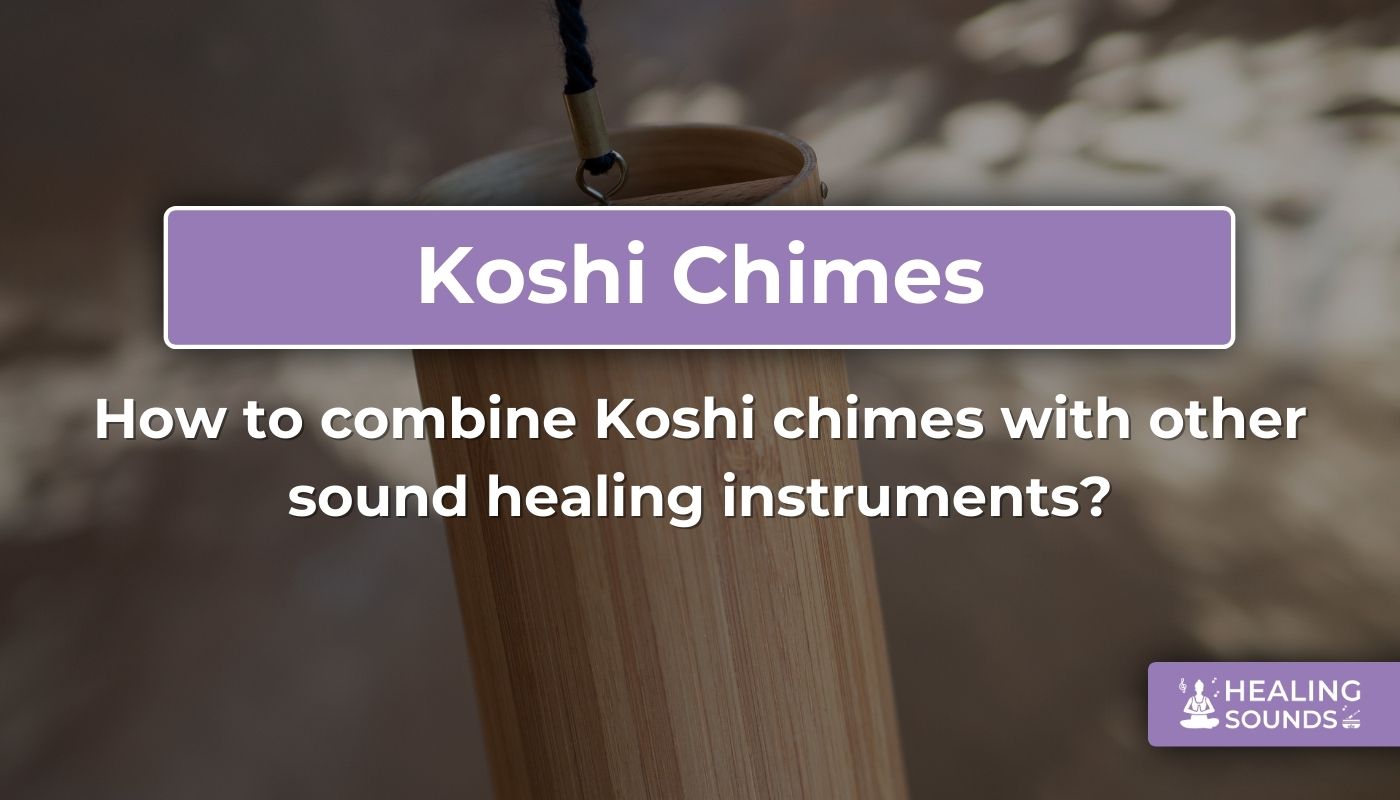Sound healing continues to captivate minds around the world, offering deep relaxation and spiritual renewal. Among the myriad instruments in this practice, koshi chimes stand out for their ethereal resonance and harmonious tones. These instruments, rooted in ancient traditions, have gained popularity in modern healing spaces. But did you ever consider combining koshi chimes with other sound healing instruments to amplify their benefits?
When you blend koshi chimes with complementary tools like singing bowls, tuning forks, and rainsticks, a symphony of healing sounds emerges. This creates an immersive experience that can elevate both mood and mindfulness. The koshi chime set of 4 elements terra aqua aria ignis, for example, brings a unique dimension to sound healing sessions. Each chime corresponds to a natural element, adding symbolic value to the therapeutic blend.
As you delve into this exploration, you’ll uncover how various instruments harmonize, enriching the healing journey. Let’s journey together through the harmonious world of sound healing, discovering how koshi wind chimes play a pivotal role. Whether you're a seasoned healer or a curious beginner, the possibilities are infinite.
So, how can you effectively combine koshi chime sounds with other instruments? What benefits arise from such combinations and what instruments pair best? Let's dive in.
Understanding the Basics of Combining Instruments
Before jumping into specific combinations, it’s crucial to understand the basics. Koshi chimes for sale often come in sets designed to complement nature’s elements. When you choose to combine these chimes with other sound healing instruments, you aim to create a harmonious blend that amplifies the healing properties.
Sound frequency and vibration form the foundation of sound healing. Each instrument produces its own unique vibration, and when combined, these vibrations work together to influence the human body’s energy fields. For instance, the koshi chime set of 4 elements terra aqua aria ignis aligns with the earth, water, air, and fire elements, creating a holistic healing experience.
Let’s examine:
- Harmonic resonance: When two or more instruments resonate at similar frequencies, their vibrations reinforce each other, enhancing the healing effect.
- Timbre interaction: The distinct timbre of each instrument impacts how sounds blend together. Choosing instruments with complementary timbres ensures a seamless auditory experience.
Think about the way a koshi chime complements a singing bowl. The clear, bell-like tones of the chime can highlight and enhance the deep, rumbling vibrations of the bowl. Such pairings encourage deeper relaxation and focus. This is where experimentation becomes key—finding the right combinations that resonate with your healing practice.
Why Combine Koshi Chimes with Other Instruments?
When you combine koshi chimes with other instruments, you unlock a multi-layered healing experience. This practice brings benefits beyond what singular instruments offer, enhancing both the auditory and emotional aspects of sound healing. The main reasons for this combination are manifold.
Expanded vibrational reach is one of the primary advantages. Individual instruments produce limited vibrational frequencies. By combining them, you expand the range significantly. This means you can target more energy centers, or chakras, in the body, leading to more comprehensive healing. For instance, the koshi chime set of 4 elements terra aqua aria ignis resonates with the natural elements, offering a broad spectrum of vibrations that can influence the energetic body deeply.
Moreover, enhanced meditation and relaxation result from these combinations. The interplay of different sounds creates a richer sonic landscape. This can help deepen meditation practice, allowing practitioners to reach states of relaxation more easily. A koshi wind chime, with its gentle and soothing tones, can act as an anchor, pulling attention inward while other instruments layer calming resonance.
Reflect on this: How often do you feel fully relaxed in your daily life? Sound healing, particularly when instruments are combined thoughtfully, can transform your daily routine into a sanctuary of tranquility.
Top Instruments to Pair with Koshi Chimes
Now that we’ve covered the basics and benefits, let’s dive into specific instruments that harmonize beautifully with koshi chimes. Each instrument brings unique qualities that enrich the healing experience, making the choice dependent on desired outcomes. Here are some top contenders:
Tibetan Singing Bowls
Tibetan singing bowls produce deep, resonant sounds that can ground and center the listener. When paired with koshi chimes, the combination is particularly potent for opening the heart and throat chakras. The deep vibrations of the singing bowls can be interspersed with the higher, clearer tones of the chimes, creating a balanced auditory field.
Try this: Begin with the singing bowl to establish a grounding atmosphere. Introduce the koshi chime gradually, allowing its tones to rise above the bowl’s vibrations. This progression mimics a journey from inner to outer awareness.
Tuning Forks
Tuning forks provide precise, targeted sound vibrations that can work directly with the body’s energy field. They pair beautifully with koshi chimes for localized healing. The chimes serve as an overall tonal backdrop, while the forks can pinpoint specific areas for deep healing.
For example, if you have tension in the neck area, use a tuning fork tuned to C and let the koshi chime sound the note A. The difference in tone will create a harmonious vibration that encourages relaxation in that region.
These are just a few examples of how koshi chimes can blend with other healing instruments for profound effects.
Practical Tips for Combining Sounds
Combining instruments may seem straightforward, but achieving the perfect harmony requires attention to detail. Here are some practical tips to guide you:
Create a Harmonious Environment
Start by ensuring your space is conducive to sound healing. Acoustic treatments can enhance the sound quality, ensuring each note is crisp and clear. The koshi chime set of 4 elements terra aqua aria ignis works best in a room that allows sound to resonate appropriately.
Positioning matters. Arrange your instruments to optimize sound flow. Place the koshi wind chime near an open window if possible, allowing natural elements to influence the vibration.
Experiment with Rhythms and Patterns
Not all combinations will resonate equally with everyone. Experiment with different rhythms and playing patterns. Try alternating between the deep tones of a Tibetan bowl and the light vibrations of a koshi chime. Observe how your body responds to these shifts and adjust accordingly.
Listen actively. As you experiment, pay attention to the sounds. Does one instrument overpower another? If so, adjust its position or the way it's played to maintain balance.
Personalization of Sound Combinations
Remember, sound healing is deeply personal. What works for one person may not for another. Encourage yourself to explore and find the combinations that resonate most with you personally. This exploration can be an integral part of the healing journey.
Case Studies: Real-Life Experiences
No discussion would be complete without examples of actual experiences. Consider these real-life stories that highlight the effectiveness of combining koshi chimes with other sound healing instruments.
Case Study 1: Maria and the Chimes
Maria, a long-time sound healer, integrated koshi chimes into her session with clients. She found that the chimes, paired with Tibetan singing bowls, significantly improved client relaxation levels. Her clients reported a deeper meditative state and enhanced overall well-being.
Case Study 2: John’s Journey
John, a yoga instructor, began incorporating koshi wind chimes and tuning forks into his classes. The combination created an immersive healing experience, guiding his students deeper into their practice. He noticed improved focus and a more profound connection to the breath during sessions.
These stories illustrate the potential power and highlight the unique benefits each practitioner found through combinations.
Conclusion
Combining koshi chimes with other sound healing instruments creates a rich, diverse healing experience that goes beyond what any single instrument can offer. From expanding vibrational reach to enhancing meditation and relaxation, the benefits are manifold. By following practical tips and experimenting with different pairings, you can tailor the healing experience to your unique needs.
In summary, embrace the journey of discovering the perfect harmony. Allow yourself the freedom to explore and find what resonates with you most. And remember, at Healing Sounds, we offer high-quality instruments to support your healing journey.
Frequently Asked Questions
Can I use koshi chimes alone, or do I need to combine them with other instruments?
While koshi chimes shine brilliantly on their own, combining them with other instruments amplifies their healing potential. However, using them alone is absolutely effective for simpler, focused sessions.
What types of koshi chimes work best with singing bowls?
The koshi chime set of 4 elements terra aqua aria ignis pairs excellently with singing bowls, offering a diverse range of tonal combinations that enrich the auditory experience.
How can I ensure my space is optimal for sound healing?
Optimize your space by considering acoustics, instrument positioning, and ambient noise levels. Create an environment where sounds can flow effortlessly, enhancing the healing impact.
Is experience necessary to combine sounds effectively, or can beginners do it?
Beginners can absolutely combine sounds. Start with simple pairings and gradually experiment. Your intuition plays a crucial role in finding the right combinations that resonate with your intention.
Where can I find high-quality koshi chimes to start my practice?
For top-notch koshi chimes and other high-quality sound healing instruments, explore our collection at Healing Sounds. Each instrument is carefully selected for its healing potential and durability.

